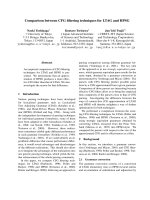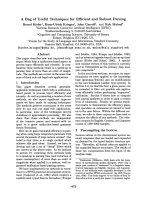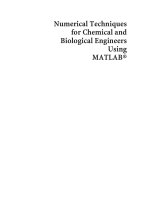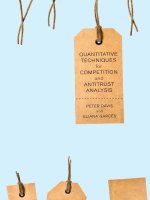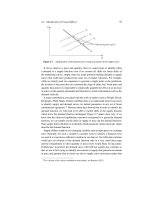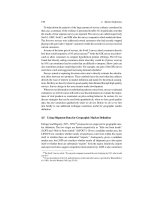Near infrared raman spectroscopy with recursive partitioning techniques for precancer and cancer detection
Bạn đang xem bản rút gọn của tài liệu. Xem và tải ngay bản đầy đủ của tài liệu tại đây (1.6 MB, 159 trang )
NEAR-INFRARED RAMAN SPECTROSCOPY WITH
RECURSIVE PARTITIONING TECHNIQUES FOR
PRECANCER AND CANCER DETECTION
TEH SENG KHOON
(B. Eng, National University of Singapore)
A THESIS SUBMITTED
FOR THE DEGREE OF MASTER OF ENGINEERING
DIVISION OF BIOENGINEERING
NATIONAL UNIVERSITY OF SINGAPORE
2009
To my parents, sister, girlfriend and friends for their
love, support and encouragement
ACKNOWLEDGEMENTS
I would like to express my heartfelt gratitude towards Dr. Huang Zhiwei, from the
Division of Bioengineering, National University of Singapore, who is the supervisor of
this research project. I would also like to acknowledge the following collaborators, Assoc.
Prof. Teh Ming from Department of Pathology (NUHS (National University Health
System) Singapore), Prof. Ho Khek Yu from Department of Medicine (NUHS,
Singapore), Assoc. Prof. Yeoh Khay Guan from Department of Medicine (NUHS,
Singapore), Assoc. Prof. Jimmy So Bok Yan from Department of Surgery (NUHS,
Singapore), and Dr. David Lau Pang Cheng from Department of Otolaryngology
(Singapore General Hospital (SGH)), for their invaluable help rendered throughout this
entire project for the past 3 years. I would further want to thank all the nurses and
colleagues including Amy from the Department of Surgery (NUHS, Singapore), Angela,
Nana, Vinnie, and Dr. Zhu Feng who are in the Gastric Clinical Epidemiology Program,
the nurses in the Endoscopy Centre from National University Hospital (NUH) and
colleagues such as Dr Zheng in the Optical Bioimaging Laboratory who have provided
various guidance and assistance during the course of this research work. On top of these,
I would like to show earnest appreciation towards my girlfriend (Clarissa), parents, sister,
and friends who have inspired me continuously to complete this project. Last but not least,
I would also like to acknowledge the following funding agencies for providing financial
support to this project, as well as my M.Eng study: Academic Research Fund from
Ministry of Education, the Biomedical Research Council, the National Medical Research
Council, and the Faculty Research Fund from the National University of Singapore.
I
Many sincere thanks to you all,
Teh Seng Khoon
NUS, Singapore 2009
II
PUBLICATIONS (PEER-REVIEWED JOURNALS)
•
S. K. Teh, W. Zheng, K. Y. Ho, M. Teh, K. G. Yeoh, Z. Huang, “Near-infrared
Raman spectroscopy for optical diagnosis in the stomach: Identification of
Helicobacter-pylori infection and intestinal metaplasia”, Intermational Journal of
Cancer 2009; DOI: 10.1002/ijc.24935.
•
S. K. Teh, W. Zheng, K. Y. Ho, M. Teh, K. G. Yeoh, Z. Huang, “Near-infrared
Raman spectroscopy for early diagnosis and typing of adenocarcinoma in the
stomach”, British Journal of Surgery 2009; DOI: 10.1002/bjs.6913.
•
Z. Huang, S. K. Teh, W. Zheng, J. Mo, K. Lin, X. Shao, K. Y. Ho, M. Teh, K. G.
Yeoh, “Integrated Raman spectroscopy and trimodal wide-field imaging
techniques for real-time in vivo tissue Raman measurements at endoscopy”,
Optics Letters 2009; 34: 758-760.
•
S. K. Teh, W. Zheng, K. Y. Ho, M. Teh, K. G. Yeoh, Z. Huang, “Near-infrared
Raman spectroscopy for gastric precancer diagnosis”, Journal of Raman
Spectroscopy 2009; 40: 908-914.
•
S. K. Teh, W. Zheng, D. P. Lau, Z. Huang. “Spectroscopic diagnosis of laryngeal
carcinoma using near-infrared Raman spectroscopy and random recursive
partitioning ensemble techniques”, Analyst 2009; 134: 1232-1239.
•
S. K. Teh, W. Zheng, K. Y. Ho, M. Teh, K. G. Yeoh, Z. Huang. “Diagnosis of
gastric cancer using near-infrared Raman spectroscopy and classification and
regression tree techniques”, Journal of Biomedical Optics 2008; 13: 034013.
•
S. K. Teh, W. Zheng, K. Y. Ho, M. Teh, K. G. Yeoh, Z. Huang, “Diagnostic
potential of near-infrared Raman spectroscopy in the stomach: differentiating
dysplasia from normal tissue”, British Journal of Cancer 2008; 98: 457-465.
III
PUBLICATIONS (CONFERENCES)
•
S. K. Teh, W. Zheng, K. Y. Ho, M. Teh, K. G. Yeoh, S. Manuel, Z. Huang,
“Image-guided Raman endoscopic probe for in vivo early detection of gastric
dysplasia”, Best free paper won on the GIHep Singapore 2009, Grand Copthorne
Waterfront, Singapore, 20-21 June 2009.
•
S. K. Teh, W. Zheng, K. Y. Ho, M. Teh, K. G. Yeoh, S. Manuel, Z. Huang,
“Image-guided Raman endoscopic probe for in vivo early detection of high grade
dysplasia”, Poster presentation presented on the Digestive Disease Week® 2009,
Mccormick place, Chicago, Illinois, 30 May-4 June 2009.
•
S. K. Teh, W. Zheng, K. Y. Ho, M. Teh, K. G. Yeoh, S. Manuel, Z. Huang,
“Early diagnosis and histological typing of gastric adenocarcinoma with nearinfrared Raman spectroscopy”, Poster presentation presented on the American
Association for Cancer Research 2009, Colorado Convention Center, Denver,
Colorado, 18-22 April 2009.
•
Z. Huang, S. K. Teh, W. Zheng, K. Y. Ho, M. Teh, K. G. Yeoh, “Image-guided
near-infrared Raman spectroscopy for in vivo detection of gastric dysplasia”, Oral
presenation presented on the SPIE/BIOS Photonic West 2009, San Jose
Convention Center, California, USA, 24-29 January 2009.
•
S. K. Teh, W. Zheng, K. Y. Ho, M. Teh, K. G. Yeoh, Z. Huang, “Near-infrared
Raman spectroscopy to identify and grade gastric adenocarcinoma”, Best oral
presentation won on the National Health Group Annual Scientific Congress 2008,
Suntec Singapore International Convention and Exhibition Centre, Singapore, 7-8
November 2008.
•
S. K. Teh, W. Zheng, K. Y. Ho, M. Teh, K. G. Yeoh, Z. Huang, “Near-infrared
Raman spectroscopy for early diagnosis of Helicobacter-pylori-associated chronic
gastritis”, Poster presentation presented on the Digestive Disease Week® 2008,
San Diego Convention Center, San Diego, California, 17-22 May 2008.
•
S. K. Teh, W. Zheng, K. Y. Ho, M. Teh, K. G. Yeoh, S. Manuel, Z. Huang,
IV
“Detection of Helicbacter-pylori-associated chronic gastritis using Raman
spectroscopy”, Poster presentation presented on the American Association for
Cancer Research 2008, San Diego Convention Center, San Diego, California, 1226 April 2008.
•
S. K. Teh, W. Zheng, K. Y. Ho, M. Teh, K. G. Yeoh, Z. Huang, “Discrimination
between normal gastric tissue and intestinal metaplasia by near-infrared Raman
spectroscopy”, Oral presentation presented on the SPIE/COS Photonics West
2008, San Jose Convention Center, California, USA, 19-24 January 2008.
•
S. K. Teh, W. Zheng, D. P. Lau, Z. Huang, “Raman spectroscopy for optical
diagnosis of laryngeal cancer”, Oral presentation presented on the SPIE/COS
Photonics West 2008, San Jose Convention Center, California, USA, 19-24
January 2008.
•
S. K. Teh, W. Zheng, K. Y. Ho, M. Teh, K. G. Yeoh, Z. Huang, “Near-infrared
Raman spectroscopy for optical diagnosis of gastric precancer”, Poster
presentation presented on the SPIE/COS Photonics Asia 2007, Jiuhua Grand
Convention and Exhibition Center, Beijing, China, 11-15 November 2007.
•
S. K. Teh, W. Zheng, K. Y. Ho, M. Teh, K. G. Yeoh, Z. Huang, “Discrimination
of gastric cancer using near-infrared Raman spectroscopy and multivariate
techniques”,
Oral
presentation
presented
on
the
World
Congress
of
Bioengineering 2007, Twin Towers Hotel, Bangkok, Thailand, 9-11 July 2007.
•
S. K. Teh, W. Zheng, K. Y. Ho, M. Teh, K. G. Yeoh, Z. Huang, “Optical
diagnosis of dysplastic lesions in the human stomach using near-infrared Raman
spectroscopy and multivariate techniques”, Poster presentation presented on the
Digestive Disease Week® 2007, Washington DC, United States of America, 19-24
May 2007.
•
S. K. Teh, W. Zheng, K. Y. Ho, M. Teh, K. G. Yeoh, Z. Huang, “Discrimination
of malignant tumor from benign tissue in the GI tract using Raman spectroscopy”,
Poster presentation presented on the Office of Life Sciences conference 2007,
Center of Life Sciences, Singapore, 5-6 February 2007.
•
Z. Huang, S. K. Teh, W. Zheng, J. C. H. Goh, “Raman spectroscopy for
V
evaluation of structure deformation in stressed bone tissue”, Oral presenation
presented on the 15th International Conference on Mechanics in Medicine and
Biology 2006, Furama Riverfront Hotel, Singapore, 6-8 December 2006.
•
Z. Huang, S. K. Teh, W. Zheng, Casey K. Chan, “Assessment of degeneration of
human articular cartilage using Raman spectroscopy”, Oral presenation presented
on the Singapore Orthopaedic Association 29th Annual Scientific Meeting 2006,
Grand Copthorne Waterfront, Singapore, 8-11 November 2006.
VI
TABLE OF CONTENTS
PAGE
ACKNOWLEDGEMENTS
I
PUBLICATIONS (PEER-REVIEWED JOURNALS)
III
PUBLICATIONS (CONFERENCES)
IV
TABLE OF CONTENTS
VII
SUMMARY
XII
LIST OF ACRONYMS
ERROR! BOOKMARK NOT DEFINED.
CHAPTER 1: INTRODUCTION
1
1.1
INTRODUCTION AND MOTIVATION
1
1.2
SPECIFIC AIMS OF THE DISSERTATION
3
1.3
ORGANIZATION OF THE DISSERTATION
4
CHAPTER 2: OVERVIEW ON RAMAN SPECTROSCOPY FOR PRECANCER AND
6
CANCER DIAGNOSIS
2.1 TECHNOLOGICAL ADVANCEMENT FOR CLINICAL RAMAN SPECTROSCOPY
SYSTEM
7
2.1.1 EXCITATION WAVELENGTH STRATEGIES FOR BIOMEDICAL RAMAN
SPECTROSCOPY
8
2.1.1.1 VISIBLE (VIS) AND NEAR ULTRA-VIOLET (UV) EXCITATION
8
2.1.1.2 DEEP UV RESONANCE RAMAN SPECTROSCOPY
9
2.1.1.3 NEAR-INFRARED (NIR) EXCITATION RAMAN SPECTROSCOPY
9
VII
2.1.2 CHARGED-COUPLED DEVICE (CCD)
11
2.1.3 SPECTROGRAPH
13
2.1.4 FIBER-OPTIC PROBE
14
2.2 AUTOFLUORESCENCE ELIMINATION APPROACHES TO ACHIEVE
BACKGROUND-FREE RAMAN SPECTRUM
15
2.2.1 TIME-GATING TECHNIQUES
16
2.2.2 SHIFTED EXCITATION RAMAN DIFFERENCE SPECTROSCOPY
16
2.2.3 FREQUENCY/WAVELENGTH-MODULATED
17
2.2.4 DIGITAL POST PROCESSING
18
2.3 REVIEW ON CANCER BIOLOGY
21
2.4 REVIEW ON RAMAN TECHNIQUE FOR PRECANCER AND CANCER DIAGNOSIS
IN DIFFERENT ORGAN SITES
23
2.4.1 BLADDER CANCER
23
2.4.2 BRAIN CANCER
24
2.4.3 BREAST CANCER
24
2.4.4 CERVICAL CANCER
25
2.4.5 GASTROINTESTINAL CANCERS
26
2.4.6 HEAD AND NECK CANCER
27
2.4.7 LUNG CANCER
28
2.4.8 ORAL CANCER
29
VIII
2.4.9 SKIN CANCER
29
2.4.10 PROSTATE CANCER
31
2.5 ANALYTICAL TECHNIQUES FOR RAMAN CLASSIFICATION
32
2.5.1 PRINCIPAL COMPONENT ANALYSIS (PCA)
34
2.5.2 HIERARCHICAL CLUSTER ANALYSIS (HCA)
35
2.5.3 LINEAR DISCRIMINANT ANALYSIS (LDA)
35
2.5.4 LOGISTIC REGRESSION (LR)
36
2.5.5 SUPPORT VECTOR MACHINES (SVM)
36
2.5.6 ARTIFICIAL NEURAL NETWORK (ANN)
37
2.5.7 RECURSIVE PARTITIONING TECHNIQUES
38
CHAPTER 3: ASSESSMENT ON THE FEASIBILITY FOR USING A RAPID FIBEROPTIC NIR RAMAN SPECTROSCOPY SYSTEM TO CHARACTERIZE RAMAN
PROPERTIES OF HUMAN TISSUE
40
3.1 RAMAN INSTRUMENTATION
41
3.1.1 UNIQUE FEATURE OF THE IN-HOUSE DEVELOPED RAMAN SYSTEM
43
3.2 DATA PREPROCESSING
45
3.3 EX VIVO TISSUE SAMPLES
48
3.4 RAMAN MEASUREMENTS
49
CHAPTER 4: NOVEL DIAGNOSTIC ALGORITHM FOR RAMAN TISSUE
CLASSIFICATION: RECURSIVE PARTITIONING TECHNIQUE –
CLASSIFICATION AND REGRESSION TREES (CART) FOR GASTRIC CANCER
52
DIAGNOSIS
IX
4.1 THEORY OF CLASSIFICATION AND REGRESSION TREES
54
4.2 DEVELOPMENT OF CART DIAGNOSTIC ALGORITHM FOR RAMAN GASTRIC
CANCER DETECTION
57
4.2.1 TISSUE RAMAN DATASET
57
4.2.2 CART APPLICATION TO THE TISSUE RAMAN DATASET
59
4.2.3 EVALUATION OF THE CART ALGORITHM WITH PROSPECTIVE STUDY
63
CHAPTER 5: IMPROVED RECURSIVE PARTITIONING TECHNIQUE FOR RAMAN
TISSUE DIAGNOSIS: AN ENSEMBLE APPROACH – RANDOM FORESTS FOR
IDENTIFICATION OF LARYNGEAL MALIGNANCY
68
5.1 RANDOM FORESTS THEORY
70
5.2 EVALUATION OF RANDOM FORESTS DIAGNOSTIC ALGORITHM FOR RAMAN
LARYNGEAL CANCER DIAGNOSIS
74
5.2.1 LARYNGEAL TISSUE RAMAN DATASET
74
5.2.2 EMPLOYMENT OF RANDOM FORESTS TO THE TISSUE RAMAN DATASET 75
CHAPTER 6: EMPIRICAL STATISTICAL ANALYSIS FOR GASTRIC PRECANCER
86
DIAGNOSIS
6.1 COMPARISON OF SPECTRAL DIFFERENCES BETWEEN NORMAL AND
DYSPLASIA GASTRIC TISSUES
87
6.2 RAMAN INTENSITY RATIO
90
6.3 OPTIMAL RAMAN INTENSITY RATIO DIAGNOSTIC ALGORITHM
93
CHAPTER 7: COMPARISON OF PERFORMANCE FOR MULTIVARIATE
STATISTICAL ANALYSIS AND EMPIRICAL STATISTICAL ANALYSIS FOR
98
GASTRIC DYSPLASIA DIAGNOSIS
X
7.1 ANALYTICAL APPROACHES
99
7.1.1 EMPIRICAL APPROACH: INTENSITY RATIO
99
7.1.2 MULTIVARIATE ANALYSIS: PCA
100
7.1.2 MULTIVARIATE ANALYSIS: LDA
104
7.1.3 COMPARISON OF PERFORMANCE FOR DIFFERENT ANALYTIC TECHNIQUES:
ROC
105
CHAPTER 8: RANDOM FORESTS DEMONSTRATION FOR GASTRIC PRECANCER
109
DETECTION
8.1 RESULTS OF THE EMPLOYMENT OF RANDOM FOREST ALGORITHM FOR
109
GASTRIC DYSPLASIA DETECTION
8.2 COMPARISON OF PERFORMANCE AMONG INTENSITY RATIO, PCA-LDA,
RANDOM FORESTS ANALYTIC ALGORITHMS FOR GASTRIC PRECANCER
DETECTION
112
CHAPTER 9: CONCLUSION AND FUTURE RESEARCH
115
BIBLIOGRAPHY
117
XI
SUMMARY
Raman spectroscopy is a molecular vibrational spectroscopic technique that is capable of
optically probing the biomolecular changes associated with disease transformation. To
effectively translate molecular differences captured in Raman spectra between different
tissue types into clinically valuable diagnostic information for clinicians, chemometrics
would need to be deployed for developing effective diagnostic algorithms for Raman
spectroscopic diagnosis of precancer and cancers. However, most of the chemometrices
(principal component analysis (PCA)) applied for Raman tissue diagnosis cannot
adequately provide the physical meanings of component spectra for tissue classification
This dissertation presents the investigation on the diagnostic utility of near infrared (NIR)
Raman spectroscopy with recursive partitioning techniques such as classification and
regression trees (CART), and random forests to construct clinically interpretable
diagnostic algorithm for tissue Raman classification.
A rapid-acquisition dispersive-type NIR Raman system was utilized for tissue Raman
spectroscopic measurements at 785 nm laser excitation. A total of 146 tissue samples
obtained from 70 patients who underwent endoscopy investigation or surgical operation
were used in this study. The histopathogical examinations showed that 94 were gastric
tissues (55 normal, 21 dysplastic, and 18 cancerous), and 50 were laryngeal tissues (20
normal, and 30 cancerous).
XII
CART was explored to be used together with NIR Raman spectroscopy for gastric cancer
diagnosis. CART achieved a predictive sensitivity and specificity of 88.9% and 92.9%,
respectively, for separating cancer from normal. In addition, CART also determined
tissue Raman peaks at 875 and 1745 cm-1 to be two of the most significant features in the
entire Raman spectral range to discriminate gastric cancer from normal tissue. This
affirmed the utility of CART to be used for NIR Raman spectroscopy detection of cancer
tissues.
To improve diagnostic performance (e.g., stability) of CART, the random ensemble
approach (i.e., random forests) was further utilized. Random forests yielded a diagnostic
sensitivity of 88.0% and specificity of 91.4% for laryngeal malignancy identification, and
also provided variables importance plot that facilitates correlation of significant Raman
spectral features with cancer transformation. These confirmed the diagnostic potential of
random forests with NIR Raman spectroscopy for detection of malignancy occurring in
the internal organs (i.e., larynx).
Comprehensive evaluation of the performance of the empirical approach that utilizes
Raman peak intensity ratio, PCA-linear discriminant analysis (LDA), and random forests
algorithm was also carried out. Raman peak intensity ratios representing biomolecular
signals for collagen, proteins and lipids achieved diagnostic accuracy of approximately
88% for NIR Raman spectroscopic detection of gastric dysplasia from the normal gastric
tissues. Further investigation on the use of PCA-LDA achieved obtained a diagnostic
accuracy of 93%, while random forests achieved diagnostic accuracy of 90% for gastric
XIII
dysplasia detection. Receiver operating characteristics (ROC) curves further confirmed
that PCA-LDA and random forests techniques have comparable overall diagnostic
accuracy rate which are more superior compared to the empirical approach.
Overall, this dissertation demonstrates that NIR Raman spectroscopy in conjunction with
powerful chemometric techniques such as random forests have the potential to generate
interpretable clinical Raman information, and to yield high diagnostic accuracy
classification results for the rapid diagnosis and detection of precancer and cancer tissues.
XIV
LIST OF FIGURES
FIGURES
PAGE
Figure 3.1 (a) Photograph of the in-house developed Raman system used to acquire tissue
Raman measurements. (b) Schematic of Raman spectroscopy system used for Raman
collection. CCD: charge-coupled device; PC: personal computer.
41
Figure 3.2 Example of a tissue raw spectrum (a) before and (b) after correcting for the
system response.
46
Figure 3.3 Example of a tissue raw spectrum (a) after noise removal via Savitsky-Golay
filter, (b) followed by fitting the autofluorescence background with a 5th order polynomial,
and (c) this polynomial was then subtracted from the raw spectrum to yield the tissue
Raman spectrum alone. Note: tissue raw spectrum and tissue Raman spectrum, black; 5th
order polynomial autofluorescence background, red.
47
Figure 3.4 Mean normalized gastric Raman spectra (solid line) ± 1 standard deviation
(SD) (gray area) obtained from a normal by multiple measurements (n=5) at various
locations for each sample. Each spectrum was normalized to the integrated area under the
curve to correct for variations in absolute spectral intensity. All spectra were acquired in
5 seconds with 785 nm excitation and corrected for spectral response of the system.
49
Figure 3.5 Mean Raman spectra of normal gastric tissues (n=55), dysplastic gastric
tissues (n=21), cancerous gastric tissues (n=18), normal laryngeal tissues (n=20), and
cancerous laryngeal gastric tissues.
50
XV
Figure 4.1 Mean Raman spectra of gastric tissues from (a) normal (n=115) and (b) cancer
(n=61) in learning Raman dataset.
58
Figure 4.2 Dependence of complexity,α, on (a) misclassification cost nodes for crossvalidated error after 10-fold cross-validation, and resubstitution error, and on (b) number
of terminal nodes for resubstitution error of the CART model learning dataset. The
optimal sized tree was chosen to be at complexity of 0.00852 with 13 terminal nodes
within one SE of the complexity-misclassification cost of the local minimum complexitymisclassification cost.
60
Figure 4.3 The optimal classification tree generated by CART method after 10-fold crossvalidation of the model learning dataset by utilizing 6 significant Raman peaks (875,
1100, 1265, 1450, 1655, and 1745 cm-1). The binary classification tree composed of 12
classifiers and 13 terminal subgroups. The decision making process involves the
evaluation of if-then rules of each node from top to bottom, which eventually reaches a
terminal node with designated class outcome, i.e., normal (N) or cancer (C).
61
Figure 5.1 Illustration of procedures for generating the random forests algorithm for
tissue classification.
71
Figure 5.2 Comparison of the mean normalized Raman spectra of normal (n=70) and
cancer (n=117) laryngeal tissue.
75
Figure 5.3 (a) Different error rates belonging to different sizes of the random forests (i.e.,
different number of trees) after the voting process on all the tissue Raman spectra. Due to
the “strong law of large number”, the error rate stabilizes to 0.107 when the forest has
XVI
more than 972 trees, highlighting that the random forests algorithm does not overfit. Note
that each of the individual trees is grown to the maximal size and left unpruned. (b) ROC
curve of tissue classification belonging to the final optimal random forests tree size of
973 with an AUC of 0.964, illustrating the diagnostic ability of Raman spectroscopy and
random forests algorithm to identify cancer from normal laryngeal tissue.
76
Figure 5.4 Variables importance plot for the Raman spectral region 800-1800 cm-1
generated from random forests size of 973 trees which was used for discrimination of
cancer from normal laryngeal tissue. The variable importance algorithm defines the most
important variable as 1, whereas the least important variable as 0. Major Raman spectral
features above the bold grey line (95% confidence interval, 13.7) are identified and listed
in Table 5.1.
78
Figure 5.5 Scatter plot of the generated probabilistic scores belonging to the normal and
cancer categories using the random forests technique together with leave-one sample-out,
cross validation method. The separate line yields a diagnostic sensitivity of 88.0%
(103/117) and specificity of 91.4% (64/70) for differentiation between normal and cancer
laryngeal tissue.
80
XVII
Figure 6.1 (a) The mean normalized NIR Raman spectra from normal (n=44) and
dysplasia (n=21) gastric mucosa tissue samples; (b) Difference spectrum ± 1.96 SD
calculated from the mean Raman spectra between normal and dysplasia tissue (i.e., the
mean normalized Raman spectrum of dysplasia tissue minus the mean normalized Raman
spectrum of normal tissue). Solid and dotted lines represent the mean spectra, and shaded
areas indicate the variance within 95% confidence interval of the mean difference of the
88
respective spectra.
Figure 6.2 Box charts of the 6 significant Raman peak intensity ratios which can
differentiate dysplasia from normal gastric mucosa tissue (unpaired Student’s t-test,
p<0.0001): (a) I875/I1450; (b) I1004/I1450; (c) I1100/I1450; (d) I1208/I1450; (e) I1745/I1450, and (f)
I1208/I1655. The dotted lines (I875/I1450 = 0.67; I1004/I1450 =0.77; I1100/I1450 = 0.71; I1208/I1450 =
0.37; I1745/I1450 = 0.26; I1208/I1655 = 0.61) as diagnostic threshold algorithms classify
dysplasia from normal with sensitivity of 76.2% (16/21), 81.0% (17/21), 95.2% (20/21),
81.0% (17/21), 95.2% (20/21), and 76.2% (16/21); specificity of 90.9% (40/44), 90.9%
(40/44), 77.3% (34/44), 88.6% (39/44), 75.0% (33/44), and 84.1% (37/44), respectively.
91
Figure 6.3 (a) Two-dimensional scatter plot showing the distribution of normal and
dysplastic gastric mucosa tissues after combining both Raman peak intensity ratios of
I1208/I1655 and I875/I1450 as a discriminating algorithm. A linear diagnostic decision
algorithm (I1208/I1655 = -0.81 I875/I1450 + 1.17) yields a sensitivity of 90.5% (19/21) and a
specificity of 90.9% (40/44) for separating dysplasia from normal tissue. (b) Receiver
XVIII
operating characteristic (ROC) curve with an area under curve (AUC) of 0.96 illustrates
the ability of Raman spectroscopy to identify dysplasia from normal gastric tissues.
95
Figure 7.1 Scatter plot of the intensity ratio of Raman signals at 875 cm-1 and 1450 cm-1,
as measured for each sample and classified according to the histological results. The
mean intensity (1.13 ± 0.46,) of normal tissue is significantly different from the mean
value (0.52 ± 0.33) of dysplasia tissue (unpaired Student’s t-test, p<0.00001). The
decision line (I875/I1450 = 0.717) separates dysplasia tissue from normal tissue with a
sensitivity of 85.7% (18/21) and specificity of 80.0% (44/55).
100
Figure 7.2 The first four diagnostically significant principal components (PCs)
accounting for about 78.5% of the total variance calculated from Raman spectra (PC1 –
42.6%, PC2 – 25.4%, PC4 – 7.9%, and PC5 – 2.6%), revealing the diagnostically
significant spectral features for tissue classification.
102
Figure 7.3 Scatter plots of the diagnostically significantly PC scores for normal and
dysplastic gastric tissue derived from Raman spectra, (a) PC1 vs. PC2; (b) PC1 vs. PC4;
(c) PC1 vs. PC5; (d) PC2 vs. PC4; (e) PC2 vs. PC5; (f) PC4 vs. PC5. The dotted lines
(PC2= 1.46 PC1 + 1.34; PC4= -1.32 PC1 + 0.94; PC5= -2.16 PC1 – 0.89; PC4= 1.74
PC2 + 0.12; PC5= 0. 84 PC2 – 0.381; PC5= -2.05 PC4 – 0.29) as diagnostic algorithms
classify dysplasia from normal with sensitivity of 90.5% (19/21), 76.2% (16/21), 71.4%
(15/21), 81.0% (17/21), 71.4% (15/21), and 71.4% (15/21); specificity of 90.9% (50/55),
80.0% (44/55), 83.6% (46/55), 80.0% (44/55), 72.7% (40/55), and 72.7% (40/55),
respectively. Circle (○): normal; Triangle (▲): dysplasia.
103
XIX
Figure 7.4 Scatter plot of the linear discriminant scores of belonging to the normal and
dysplasia categories using the PCA-LDA technique together with leave-one spectrum-out,
cross-validation method. The separate line yields a diagnostic sensitivity of 95.2% (20/21)
and specificity of 90.9% (50/55) for differentiation between normal and dysplasia tissue.
105
Figure 7.5 Comparison of ROC curves of discrimination results for Raman spectra
utilizing the PCA-LDA-based spectral classification with leave-one spectrum-out, crossvalidation method and the empirical approach using Raman intensity ratio of I875/I1450.
The integration areas under the ROC curves are 0.98 and 0.88 for PCA-LDA-based
diagnostic algorithm and intensity ratio algorithm, respectively, demonstrating the
efficacy of PCA-LDA algorithms for tissue classification.
106
Figure 8.1 (a) Different error rates belonging to different sizes of the random forests (i.e.,
different number of trees) after the voting process on all the tissue Raman spectra.
Stabilization of forests occurred at 0.105 after more than 284 trees, illustrating that the
random forests algorithm does not overfit. (b) ROC curve of tissue classification
belonging to the final optimal random forests tree size of 1000 with an AUC of 0.950,
illustrating the diagnostic ability of Raman spectroscopy and random forests algorithm to
identify gastric dysplasia from normal gastric tissue.
110
Figure 8.2 (a) Scatter plot of the generated probabilistic scores belonging to the normal
and dysplasia categories using the random forests technique together with leave-one
sample-out, cross validation method. The separate line yields a diagnostic sensitivity of
81.0% (17/21) and specificity of 92.7% (51/55) for differentiation between normal and
XX
dysplastic gastric tissue. (b) Variables importance plot for the Raman spectral region 8001800 cm-1 generated from random forests size of 1000 trees which was used for
discrimination of dysplasia from normal gastric tissue. The variable importance algorithm
defines the most important variable as 1, whereas the least important variable as 0.
Notable peaks are identified.
111
Figure 8.3 Comparison of ROC curves of discrimination results for Raman spectra
utilizing the Raman intensity ratio of I875/I1450, PCA-LDA and the random forests
algorithm. The integration areas under the ROC curves are 0.88, 0.98, and 0.95 for
intensity ratio algorithm , PCA-LDA-based, and random forests-based diagnostic
algorithm and intensity ratio algorithm, respectively, demonstrating the efficacy of PCALDA algorithms for tissue classification.
113
XXI
LIST OF TABLES
TABLES
PAGE
Table 2.1 Raman peak features commonly found in the literature for biomedical studies
with tenative biochemical assignments.
20
Table 3.1 Type and number of human tissues collected.
48
Table 3.2 Tentative assignments of the major Raman peaks identified in gastric and
laryngeal tissues.
51
Table 4.1 Statistical characteristics of diagnostically significant Raman peaks (unpaired
two-sided Student’s t-test, p<0.05; 80% of total Raman dataset).
59
Table 4.2 The variable rankings of all the input Raman peak intensity features (n=7)
computed by the CART algorithm, with the corresponding total number of times of the
respective feature appearing in the final CART-based diagnostic model.
63
Table 4.3 Classification results of Raman prediction of the 2 pathological groups with the
model learning dataset (80% of total dataset) using the 10-fold cross-validation method,
and the validation dataset (20% of total dataset) using a CART-based diagnostic
algorithm.
64
Table 5.1 Tentative assignments of the Raman peaks identified in laryngeal tissue (Fig.
5.4, variables importance plot), mean intensity changes (increase +/decrease −) of cancer
with respect to normal, and p-values of unpaired two-sided Student’s t-test on Raman
peak intensities of normal and cancer laryngeal tissue.
79
XXII
Table 6.1 Results of predicted sensitivity, specificity and accuracy for discrimination of
gastric dysplasia from gastric normal tissue using the pairwise combinations of Raman
peak intensity ratios.
94
XXIII

